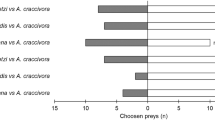Abstract
The armoured scale insects Acutaspis umbonifera (Newstead), Pinnaspis buxi (Bouché) (Homoptera: Diaspididae) and the soft scale insects Saissetia coffeae (Walker) and Coccus hesperidum L. (Homoptera: Coccidae) were tested as suitable prey for the ladybird Chilocorus nigritus (F.) (Coleoptera: Coccinellidae), with a view to using the beetle as a biological control agent in UK glasshouses. C. nigritus larvae were able to complete development on all prey species tested and adults were also able to mature eggs on P. buxi, S. coffeae and C. hesperidum (A. umbonifera was not tested in this respect). Prey in ornamental glasshouses and interior landscapes are often diverse and patchily distributed. Thus the effect on the beetle larvae of switching between diaspidid and coccid prey was also examined. Larvae were able to switch from feeding on C. hesperidum to Abgrallaspis cyanophylli (Signoret) (Homoptera: Diaspididae) and vice versa with only minor detrimental effects when compared to those beetles reared throughout on one prey species. Introductions of C. nigritus as eggs, rather than adults are indicated for the control of soft scale species.
Similar content being viewed by others
References
Blumberg D, Swirski E (1977) Mass breeding of two species of Saissetia (Hom.: Coccidae) for propagation of their parasitoids. Entomophaga 22:147–150
Chazeau J (1981) La lutte biologique contre la cochenille transparente du cocotier Temnaspidiotus destructor (Signoret) aux Nouvelles-Hébrides (Homoptera: Diaspididae). Cah O.R.S.T.O.M. Sér Biol, No. 44, pp 11–22
Copland MJW, Ibrahim AG (1985) Biology of glasshouse scale insects and their parasitoids. In: Hussey NW, Scopes NEA (eds) Biological pest control, the glasshouse experience. Blandford Press, Dorset, pp 87–90
Dixon AFG (2000) Insect predator–prey dynamics: ladybird beetles and biological control. Cambridge University Press, Cambridge
Evans EW, Stevenson AT, Richards DR (1999) Essential versus alternative foods of insect predators: benefits of a mixed diet. Oecologia 121:107–112
Greathead DJ, Pope RD (1977) Studies on the biology and taxonomy of some Chilocorus spp. (Coleoptera: Coccinellidae) preying on Aulacaspis spp. (Hemiptera: Diaspididae) in East Africa, with the description of a new species. Bull Entomol Res 67:259–270
Hattingh V, Samways MJ (1991a) Determination of the most effective method for field establishment of biocontrol agents of the genus Chilocorus (Coleoptera: Coccinellidae). Bull Entomol Res 81:169–174
Hattingh V, Samways MJ (1991b) A forced change in prey type during field introductions of coccidophagous biocontrol agents Chilocorus species (Coleoptera: Coccinellidae): is it an important consideration in achieving establishment. In: Polgár L, Chambers RJ, Dixon AFG, Hodek I (eds) Behaviour and impact of Aphidophaga. Proceedings of the 4th meeting of the IOBC working group, Ecology of Aphidophaga. SPB Academic Publishing, The Hague, The Netherlands, pp 143–148
Heidari M (1989) Biological control of glasshouse mealybugs using coccinellid predators. Ph.D. thesis, Department of Biological Sciences, Wye College, University of London, 372 pp
Hodek I, Honĕk A (1996) Ecology of the Coccinellidae. Kluwer Academic Publishers, Dordrecht, The Netherlands
Jalali SK, Singh SP (1989) Biotic potential of three coccinellid predators on various diaspine hosts. J Biol Control 3:20–23
Jalaluddin SM, Thirumoorthy S, Mohanasundaram M, Chinnia C, Chinnaswami KN (1991) Coccid complex of coconut in Tamil Nadu. Indian Coconut J 22:17
Kehat M (1968) The feeding behaviour of Pharoscymnus numidicus (Coccinellidae), predator of the date palm scale Parlatoria blanchardi. Entomol Exp Appl 11:30–42
Kosztarab M (1997) Ornamental and house plants. In: Ben Dov Y, Hodgson CJ (eds) Soft scale insects their biology, natural enemies and control, world crop pests 7B. Elsevier, Amsterdam, pp 357–366
Mendel Z, Podoler H, Rosen D (1985) A study of the diet of Chilocorus bipustulatus (Coleoptera: Coccinellidae) as evident from its midgut contents. Israel J Entomol 19:141–146
Michaud JP (2005) On the assessment of prey suitability in aphidophagous Coccinellidae. Eur J Entomol 102:385–390
Nishida R, Fukami H (1989) Host plant iridoid-based chemical defense of an aphid, Acyrthosiphon niponnicus, against ladybird beetles. J Chem Ecol 15:1837–1845
Ponsonby DJ (1995) Biological control of glasshouse scale insects using the coccinellid predator, Chilocorus nigritus. Ph.D. thesis, Department of Biological Sciences, Wye College, University of London, 437 pp
Ponsonby DJ, Copland MJW (1996) Effect of temperature on development and immature survival in the scale insect predator, Chilocorus nigritus (F.) (Coleoptera: Coccinellidae). Biocontrol Sci Technol 6:101–109
SAS Institute (1992) SAS software version 6. SAS Institute, Cary
Samways MJ (1984) Biology and economic value of the scale insect predator Chilocorus nigritus (F.) (Coccinellidae). Biocontrol News Inf 5:91–105
Samways MJ, Mapp J (1983) A new method for the mass introduction of Chilocorus nigritus (F.) (Coccinellidae) into citrus orchards. Citrus Subtropical Fruit J 598:4–6
Samways MJ, Wilson SJ (1988) Aspects of the feeding behaviour of Chilocorus nigritus (F.) (Coleoptera: Coccinellidae) relative to its effectiveness as a biocontrol agent. J Appl Entomol 106:177–182
Tirumala Rao V, Leela David A, Mohan Rao KR (1954) Attempts at the utilisation of Chilocorus nigritus (F.) (Coleoptera: Coccinellidae) in the Madras State. Indian J Entomol 16:205–209
Vesey-Fitzgerald D (1953) Review of the biological control of coccids on coconut palms in The Seychelles. Bull Entomol Res 44:405–413
Acknowledgements
The work was carried out at Wye College and funded by the former U.K. Ministry of Agriculture Fisheries and Food. We thank Dr Trudy Watt for statistical advice, Jon Varley and Sue Stickels for technical help and Dr A.I. Mohyuddin of the International Institute of Biological Control, Rawalpindi for providing the nucleus stock of C. nigritus. We also thank Mr Mike Marsh of the Royal Botanic Gardens, Kew and Mr Ivor Stokes, former Curator of the National Botanic Gardens of Wales, for providing the initial diaspidid inocula.
Author information
Authors and Affiliations
Corresponding author
Rights and permissions
About this article
Cite this article
Ponsonby, D.J., Copland, M.J.W. Aspects of prey relations in the coccidophagous ladybird Chilocorus nigritus relevant to its use as a biological control agent of scale insects in temperate glasshouses. BioControl 52, 629–640 (2007). https://doi.org/10.1007/s10526-006-9066-9
Received:
Accepted:
Published:
Issue Date:
DOI: https://doi.org/10.1007/s10526-006-9066-9




